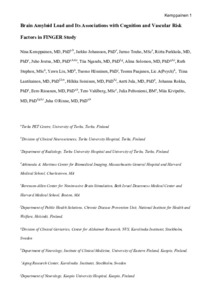Brain amyloid load and its associations with cognition and vascular risk factors in FINGER study
Nina Kemppainen; Jarkko Johansson; Jarmo Teuho; Riitta Parkkola; Juho Joutsa; Tiia Ngandu; Alina Solomon; Ruth Stephen; Yawu Liu; Tuomo Hänninen; Teemu Paajanen; Tiina Laatikainen; Hilkka Soininen; Antti Jula; Johanna Rokka; Eero Rissanen; Tero Vahlberg; Julia Peltoniemi; Miia Kivipelto; Juha O. Rinne
Brain amyloid load and its associations with cognition and vascular risk factors in FINGER study
Nina Kemppainen
Jarkko Johansson
Jarmo Teuho
Riitta Parkkola
Juho Joutsa
Tiia Ngandu
Alina Solomon
Ruth Stephen
Yawu Liu
Tuomo Hänninen
Teemu Paajanen
Tiina Laatikainen
Hilkka Soininen
Antti Jula
Johanna Rokka
Eero Rissanen
Tero Vahlberg
Julia Peltoniemi
Miia Kivipelto
Juha O. Rinne
Wolters Kluwer
Julkaisun pysyvä osoite on:
https://urn.fi/URN:NBN:fi-fe2021042718019
https://urn.fi/URN:NBN:fi-fe2021042718019
Tiivistelmä
To investigate brain amyloid pathology in a dementia-risk population defined as cardiovascular risk factors, aging, and dementia risk (CAIDE) score of at least 6 but with normal cognition and to examine associations between brain amyloid load and cognitive performance and vascular risk factors.
Twenty participants (42%) had a positive PiB-PET on visual analysis. The PiB-positive group performed worse in executive functioning tests, included more participants with APOE ε4 allele (50%), and showed slightly better glucose homeostasis compared to PiB-negative participants. PiB-positive and -negative participants did not differ significantly in other cognitive domain scores or other vascular risk factors. There was no significant difference in Fazekas score between the PiB groups.
A subgroup of 48 individuals from the Finnish Geriatric Intervention Study to Prevent Cognitive Impairment and Disability (FINGER) main study participated in brain 11C-Pittsburgh compound B (PiB)-PET imaging, brain MRI, and neuropsychological assessment at the beginning of the study. Lifestyle/vascular risk factors were determined as body mass index, blood pressure, total and low-density lipoprotein cholesterol, and glucose homeostasis model assessment. White matter lesions were visually rated from MRIs by a semiquantitative Fazekas score.
The high percentage of PiB-positive participants provides evidence of a successful recruitment process of the at-risk population in the main FINGER intervention trial. The results suggest a possible association between early brain amyloid accumulation and decline in executive functions. APOE ε4 was clearly associated with amyloid positivity, but no other risk factor was found to be associated with positive PiB-PET.
OBJECTIVE
RESULTS
METHODS
CONCLUSIONS
Twenty participants (42%) had a positive PiB-PET on visual analysis. The PiB-positive group performed worse in executive functioning tests, included more participants with APOE ε4 allele (50%), and showed slightly better glucose homeostasis compared to PiB-negative participants. PiB-positive and -negative participants did not differ significantly in other cognitive domain scores or other vascular risk factors. There was no significant difference in Fazekas score between the PiB groups.
A subgroup of 48 individuals from the Finnish Geriatric Intervention Study to Prevent Cognitive Impairment and Disability (FINGER) main study participated in brain 11C-Pittsburgh compound B (PiB)-PET imaging, brain MRI, and neuropsychological assessment at the beginning of the study. Lifestyle/vascular risk factors were determined as body mass index, blood pressure, total and low-density lipoprotein cholesterol, and glucose homeostasis model assessment. White matter lesions were visually rated from MRIs by a semiquantitative Fazekas score.
The high percentage of PiB-positive participants provides evidence of a successful recruitment process of the at-risk population in the main FINGER intervention trial. The results suggest a possible association between early brain amyloid accumulation and decline in executive functions. APOE ε4 was clearly associated with amyloid positivity, but no other risk factor was found to be associated with positive PiB-PET.
OBJECTIVE
RESULTS
METHODS
CONCLUSIONS
Kokoelmat
- Rinnakkaistallenteet [27094]
